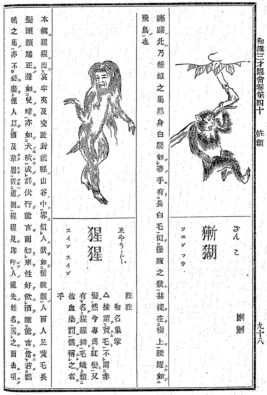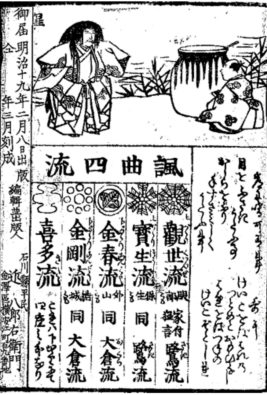Creatures of Myth and Modernity: Meiji-Era Representations of Shōjō (Orangutans) as Exotic Animals
Published June 29, 2017
Pages 71-93
https://doi.org/10.21159/nvjs.09.04
© The Japan Foundation, Sydney and Daniel J. Wyatt, 2017

This work is licensed under a Creative Commons Attribution-NonCommercial-NoDerivatives 4.0 International License.
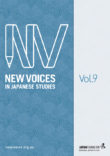
New Voices
in Japanese Studies
Volume 9
© The Japan Foundation, Sydney, 2017
Abstract
This study investigates the multiple representations of shōjō in the translated literature and print media of Japan’s Meiji era. It explores the origins of the shōjō as a yōkai, or mythical being of traditional folklore and Noh theatre, through to its unveiling as a real-life creature of the modern world, as an orangutan, initially at misemono sideshows, before its introduction to the Tokyo public at the Ueno Zoo, in 1898. The zoo, as a new framework for ordering the relationship between people and the natural world, is one of the cultural systems through which knowledge of the shōjō was constructed, circulated and experienced in this period. Examining such materials, the paper reveals contesting knowledge systems that contributed to modern experience. Translation also plays an important role in this process, and the translated literature of this era is explored and foregrounded here as an active contributor to the creation and transition of knowledge of exotic animals like the shōjō in late nineteenth- and early twentieth-century Japan.
INTRODUCTION
During the Meiji era [1868—1912], several species of exotic’ animals became transfer points for cultural configurations, including the rakuda (駱駝; camel), zō (象; elephant), kirin (麒麟; giraffe), tora (虎; tiger) and shōjō (猩々; orangutan). The interrelated meanings of traditional symbols that were projected onto such animals during this period reveal various cultural systems through which knowledge of exotic creatures was constructed and how their representations in the public imaginary transitioned and transformed. Translation of literature also functions as a key component in this analysis, as it not only highlights cultural interference in the rendering of language but also impacts knowledge production by manipulating meaning and enacting processes of transition and transformation. Accordingly, through a cultural biography of the representation and circulation of shōjō in the translated literature and print media of the Meiji era, this study explores three key themes: the shōjō as a cultural symbol and a creature of myth, the emergence of the shōjō as a real-life animal and a symbol of modernity, and the tension created at the intersection of these two conflicting views. Shifting representations of the shōjō presented in this paper highlight the complex relationship that existed between Meiji society and the cultural understanding of animals, but may also act as a reference point and resource for further avenues of study relating to the relationship between traditional knowledge and science, culture and animals, and nature and the built environment. More broadly, such research has implications for understanding the creation and transition of knowledge, as well as overlapping knowledge systems, in late nineteenth- and early twentieth-century Japan.
The history of the shōjō reveals a duality of meaning associated with the creature, from its origins as a preternatural, mythical creature of Chinese and Japanese folklore, to a real-life specimen of the natural world, as it met with advances in modern science and a rapidly changing society striving towards bunmei kaika (文明開化; civilization and enlightenment). With the establishment of Japan’s first zoo, the Ueno Imperial Zoological Gardens (東京都恩賜上野動物園) (commonly referred to as Ueno Zoo or Ueno Dōbutsuen [上野動物園]), in 1882, exhibition, spectatorship and the production of knowledge became interrelated in a public spectacle. With the introduction of this new space that merged elements of traditional culture and modern recreation, representations of animals and wildlife transmuted and transitioned into different cultural forms, contexts and meanings.
MISEMONO AND INTERACTIONS WITH THE EXOTIC
Spanning the Sumida River (隅田川) in Tokyo, Ryōgoku Bridge (両国橋) was one of a number of sites throughout Japan that featured a form of entertainment popular in the pre-Meiji era known as misemono (見世物; exhibitions or sideshows).1 These misemono exhibits included all manner of exotic’ creatures and performances, as well as native Japanese animals and a myriad of traditional cultural beings referred to as yōkai (妖怪) and bakemono (化け物): preternatural creatures of indigenous folklore. As Gerald Figal states:
[S]upernatural signifiers commonly associated with the beliefs of an unsophisticated rural populace (although equally produced and reproduced in the city) saturated both city and country in mid-nineteenth-century Japan to a surprising degree and were available for reuse in new texts and contexts. (Figal 1999, 24)
Belief in bakemono and other kinds of supernatural creatures had persisted for centuries throughout Japan, but with rapidly changing political, social and economic institutions, and a growing demand for new forms of entertainment amidst an increasingly urbanising society, these creatures of traditional culture began to intersect with modern life, creating new readings and meanings of social significance—one reason for the popularity of misemono.
In his Misemono kenkyū [見世物研究; Misemono Studies’], Asakura (2002) categorises misemono attractions into three types: gijutsu (技術) or techniques’, including magic, acrobatics, spinning tricks, displays of strength, and balancing acts; tennen kibutsu (天然奇物) or natural curiosities’, including so-called freaks, rare beasts, and strange fish and insects; and saikumono (細工物) or craftworks’, including clay and papier-mâché dolls, and various types of boxes, shells, paper and flowers (13). Exotic’ animals like the orangutan therefore corresponded to the second category, natural curiosities. Kuroda (1994) points out that this type of misemono was a ”culmination of the foreign, the different, and the other-worldly” (異人性・異類性・異界性の極致) (60—61), and it was this element of the kikai (奇怪; strange or uncanny) that attracted people. Writing earlier, Furukawa (1970) further classified animals that correspond to this category of natural curiosities into seven subcategories:
- Nihonsan (日本産; native Japanese) animals that were still relatively unusual to see up close for the average citizen, like wolves, monkeys, and foxes;
- Reijū (霊獣) or sacred beasts’, which was often merely an embellished title to attract customers—as in the case of the sennen mogura (千年土龍; thousand-year-old mole’)2;
- Kikei (畸形) or deformities’, like deformed cows and dogs;
- Kaijū (海獣) or sea beasts’, used to classify whales and seals;
- Karatori (唐鳥) or foreign birds’, like peacocks and parrots3;
- Gaikoku watari no dōbutsu (外国渡りの動物)4 or imported beasts’, like tigers and elephants; and,
- Gyorui (魚類), for various types of rare and peculiar fish (153).
In some cases, however, a single creature could appear as a motif in multiple categories. In relation to the shōjō, for instance, Furukawa cites examples such as: a koi (鯉; carp) fish exhibited as a shōjō koi (猩々鯉) due to its red colour, which was extremely rare at the time (171); the shōjō mai (猩々舞), a dance originally performed as a Shinto ritual in which a performer dressed in a Noh-style shōjō costume danced around the rim of a large pot (110); and an albino boy with reddish-brown hair, born of immaculate conception after a woman’s mysterious encounter with a shōjō of the sea, put on display by his mother for all to see as a way of ”expiating her sins” (罪障消滅のため) (143—44). The shōjō motif is drawn upon here through multiple pathways of knowledge that stem from both its original representation as a monkey-like, mythical creature of Chinese origin, and aspects of the story as it was adapted into Japanese folklore and Noh tradition. This highlights how elements of the shōjō crossed over into different categories and systems of interpretation, including shōjō as imported animal’ (orangutan), shōjō as rare fish’ (shōjō koi), shōjō as religious dance or performance (shōjō mai), and shōjō as deformity’ (albino with red hair).
Of the seven categories identified by Furukawa, however, the foreign or imported creatures were the most sought after (164). Particularly popular amongst these animals were the tiger, cheetah, elephant, orangutan and camel, and their imagery and reproduction can be found in various forms of art and literature from the period. Kawazoe (2000) indicates not only the ”rarity” (珍しさ) but also the ”value” (ありがたさ) and potential ”benefit” (ご利益) attributed to imported animals, all of which impacted the public imaginary of both the foreign creatures and the countries from which they came (91—126). Benefit’ here refers to the properties of these various animals that were considered akubyōharai (悪病払い), i.e., something able to ward off illness. Cassowary feathers, for example, were said to prevent the contraction of smallpox (疱瘡麻疹疫疹のまじなひになる), hence many spectators would visit misemono stands that exhibited cassowaries in the hope of retrieving a feather to help ward off such illness (Kawazoe 2000, 94—95). Camels were similarly believed to ward off disease and even help one achieve fūfuwagō (夫婦和合; conjugal harmony), such that medicines made from camel urine were referred to as reiyaku (霊薬) or miracle drugs’.
The popularity of misemono exhibits peaked around the mid-nineteenth century. However, through a series of ordinances introduced by the new Meiji government between 1870 and 1873 opposing various carnivalesque practices, the misemono began a steady decline (Figal 1999, 25—26). It seems hardly surprising, therefore, that when Tokyo’s first zoo was established at Ueno in 1882 as part of the National Museum of Natural History,5 barely a decade after the introduction of laws targeting misemono, ”[t]he Japanese came to perceive zoos as amusement parks rather than as facilities for promoting education and the scientific study of animals, as well as for breeding animals for the preservation of species” (Itoh 2010, 18).
The inception of Ueno Zoo in 1882 and its reception by the public, as reflected in the translated literature and print media of this era, provides insights into how the zoo both mirrored and embodied changes within Japanese culture, identity and politics throughout the later Meiji period. With the progression of modernity, the public’s view of foreign animals as creatures of awe and as quasi-spiritual beings shifted towards seeing them as objects of human rule and symbols of power. Perhaps the clearest example of this was the capture of animals by Japanese soldiers during the Sino-Japanese (1894—1895) and Russo-Japanese (1904—1905) Wars, labelled senrihin dōbutsu (戦利品動物; animal war trophies), which served as symbolic representations of the conquest of foreign lands. The exhibition of these animals at Ueno Zoo, as well as those that were gifted by other nations, thus functioned as a showcase of imperial power. A variety of animals, including dogs, horses, donkeys and camels were mobilised in military service as gun‘yō dōbutsu (軍用動物; military animals) during these wars and the public could read about the animals and their performance of imperial duty in newspaper media, or otherwise witness it for themselves at Ueno Zoo’s senkō dōbutsu (戦功動物; distinguished war animal) enclosures. Beginning in 1937, Ueno Zoo even held special events, such as the senkō dōbutsu kansha no kai (戦功動物感謝の会; lit., gathering for the commemoration of distinguished war animals’) and gun‘yō dōbutsu ireisai (軍用動物慰霊祭; lit., military animal memorial service’), as a show of appreciation to such animals for their distinguished war service.6 Thus, like the living trophies’ exhibited at Ueno Zoo that served as spectacle while also demonstrating to the public the products of empire, the zoo itself performed a binary role: as a symbol of the government’s ability to compete with Western civilization and as a tool to educate the public on modern taxonomic systems, on the one hand; and, on the other, as a stage for the new Japanese empire to flaunt its power through the capture and exhibition (i.e., control) of creatures from foreign lands.
Miller (2013) similarly highlights the creation of Ueno Zoo and its links to Japanese imperialism, but also cites the function of the zoo as a site for producing civilization that purposely contrasted with earlier misemono, as an institution that emulated Western scientific thought. He argues that Ueno Zoo’s ”wild” animals, from a natural world somewhere ”out there” (i.e., beyond civilised, modern Japan), organised into carefully planned exhibits for privileged observation, instituted the paradox of Japan’s ”ecological modernity”—a term denoting the two-fold process of social transformation and intellectual separation of people from the natural world (2—3). The opening of Ueno Zoo certainly evinced the first significant change in context for the collection, display and representation of exotic animals distinct from practices of the misemono in early Meiji and previous eras. However, this disjuncture, particularly in the years immediately following its inception through to the end of the Meiji period, by no means represents a clear-cut departure from earlier exhibition practices. In many ways, this new’ institution inherited the cultural attitudes of misemono proprietors, patrons and spectators regarding the treatment and interpretation of exotic animals, before they could transition into new forms of knowing and doing.
Shōjō AS PRETERNATURAL CREATURE
The word exotic’ was commonly translated in dictionaries throughout the Meiji era as ikoku (異国; foreign) or hakurai (舶来; imported) and was used to describe animals, people and products of other lands. It was not until the late Meiji, then Taishō [1912—1926] and early Shōwa [1926—1989] periods— concurrent with the changing implications of exoticism’ in the West—that the term came to be translated as ikoku jōchō (異国情調),7 literally meaning foreign air’ and thus referring to a state of mind. As such, foreign animals or hakurai dōbutsu’ imported into Meiji Japan were admired as exotic items in the general sense, as creatures of distant lands. Interestingly, however, the shōjō’ was not exactly a new creature to Japan, having in fact been known there for hundreds of years as a creature of myth. Thus, when an actual shōjō was first introduced at Ueno Zoo in 1898, one can imagine people’s fascination to learn not only that the shōjō was real and on display in Tokyo, but that it was a very different creature to that of the well-known traditional tales.
The shōjō of Japanese folktales and Noh plays is a type of preternatural creature originating in China (see Figure 1). Early documentation of the Chinese shōjō can be found in a translation of the Illustrated Sino-Japanese Encyclopedia’, Wakan sansai zue [和漢三才図会], compiled by Ryōan Terajima (寺島 良安) and first published in 1712. However, in a note preceding the introduction of the creature, Terajima comments that the original text states that
the fur of the shōjō is originally yellow not red, but the fur of the shōjō as it is known today is red. Furthermore, it states that there is a type of fabric called shōjōhi [猩猩緋; scarlet], which is a type of rug made by dying the fur of the yellow shōjō in its own blood. But surely this is just a made-up name.[8「按謂黄毛不謂赤髮然今專爲紅髮又有名猩猩緋毛織類彼血染罽僞稱之者乎」]
(Terajima 1888, 98)
Figure 1: The original Chinese shōjō’, left, as it appears in Wakan sansai zue (和漢三才図会), compiled by Ryōan Terajima (寺島 良安) and published in 1712, reprinted in 1888. (Click image to view larger version.)
One can surmise from this that knowledge of the shōjō had already been imported and adapted into Japanese culture by this time. The translation of the explanation of the creature that follows reads:
Shōjō live in the mountains and valleys of Ailao [哀牢夷; the remote mountain regions in the northwest of present day Yunnan] and in the Fengxi County in Jiaozhi [交趾; present day northern Vietnam]. It is a type of monkey that has the legs and face of a human, but with a square-shaped head and long yellow fur. The sound it makes is like the cry of a baby or the bark of a small dog. Shōjō move around covertly and in groups. They also know how to speak and they love to drink sake. While it is said that they can speak, that doesn’t necessarily mean they can speak clearly like a parrot. To catch a shōjō, local people leave a pair of zōri sandals and some sake by the side of the road. The shōjō will come to that spot, curse the ancestors of those who left these things, then leave. But after a short while the shōjō would return to drink the sake and wear the sandals. While they are enjoying themselves, people capture them and keep them in cages to be raised and eaten as food. When one is to be killed, the fattest one is chosen and it weeps sadly. In the barbarian regions to the northwest [西胡; Xihu], they use the blood of the shōjō to dye a type of woollen fabric because their blood doesn’t darken [i.e., it remains a vibrant red]. When they take blood from the shōjō someone will flog it with a whip and ask it how much to take. Once they have collected one to [斗; approximately 18 litres], they stop.[9「本綱猩猩出哀牢夷及交趾封溪縣山谷中出畧似人状如猨猴類人面人足黄毛長髮頭顏端正聲如兒啼亦如犬吠成群伏行能而知來性好酒飲雖能言當若鸚之屬亦不必盡俚人以酒及草履置道側猩猩見即人祖先姓名呼罵之而去頃復相與嘗酒履著因而彼擒檻而養之將烹則推其肥者泣而遣之西胡取其血染毛罽不黯刺血必箠而問其數至一斗乃已」]
(Terajima 1888, 98—99)
Apart from the difference in colour, the shōjō that flourished in the Japanese imaginary throughout the Edo and early Meiji periods is akin to that described in Terajima’s translation; that is, a monkey-like creature that likes to drink sake and has the ability to speak. And while some interpretations perpetuate the theme of capturing a shōjō (although not for specific purposes such as food or textiles), the animal that was introduced and adapted into the cultural sphere of Japanese Noh and folklore was not a yellow-haired creature of the mountains, but a red-haired water dweller that brought good fortune. The Noh version tells of a man in China named Kōfū (高風) who lived in the village of Yōzu (揚子), at the foot of Mount Kanekin (金山). One night Kōfū has a dream that tells him he will become rich if he sells sake at the market in Yōzu. Following the dream, he begins to sell sake and becomes a wealthy man. One day Kōfū notices that the face of one of his customers never turns red, no matter how much he drinks. When Kōfū asks his name, the man replies that he is a shōjō who lives in the ocean. He tells Kōfū that if he brings some sake to the bank of the Yangtze River (潯陽の江のほとり), he will emerge from the waters to greet him. Later that day Kōfū goes down to the riverbank carrying sake and waits for the shōjō to appear. As the stars and moon begin to illuminate the night sky the shōjō appears before Kōfū; delighted to see him, the shōjō drinks the sake and dances merrily. Once he is finished, as a token of his appreciation, he presents Kōfū with a magic sake jar that never runs dry. Kōfū then wakes to find he has been dreaming, but sees that the magic jar remains.8 While the author of the original tale is unknown, the story is believed to have been in circulation from the Muromachi
through to the Edo period [1603—1868], with many variations, often relocating the setting to various regional sites around Japan (Nishino 1998, 412—14). Many examples can be found of performances of the tale in the Meiji era (see Figure 2), as well as its continued circulation in printed media, some examples of which are discussed below.
Figure 2: Kōfū waits by the river with a pot of sake. Illustration of a performance of the Noh tale, ”Shōjō”, in Hōshōkoutai shoshÅ«gen [宝正小謡諸祝言] by Hachirōemon Kon [近 八郎右衛門] in 1886. (Click image to view larger version.)
Significantly, the period in which these stories first circulated and were filtered through Japanese culture and customs coincides with the sakoku (鎖国; lit., closed country’) policy that prohibited Japanese people from going abroad and heavily restricted foreign trade and diplomatic relations to a few select countries. The sakoku policy created major restrictions on the pursuit of knowledge to the extent that when Japanese people were confronted with exhibits of real-life orangutan referred to as shōjō’—reportedly exhibited three times during the Edo period—the imagery and treatment of these animals was processed through familiar folktales and supernatural ideas, which heavily inflected systems of knowing the world for most people in Japan during this time. Yet, despite the abolishment of the sakoku policy and the transition from a closed, feudal society towards a modern state with the establishment of the Meiji government, the dissemination of new knowledge continued to circulate through and be negotiated by earlier systems of knowledge, particularly with regard to foreign or exotic phenomena, including animals like the shōjō. In the tōshoran (投書欄; letters to the editor column) of the Yomiuri Shimbun [読売新聞] newspaper on 7 October 1875, one reader reports their confusion about the display of a monkey exhibited as a shōjō’:
They say that newspaper reporters impart wisdom to the people, so I would like someone to answer something for me. I read an article in another newspaper, not your newspaper, in which somebody wrote, ”There was a sideshow in Owari until recently, which was trying to trick people into coming to see a shōjō, which was really a monkey that had been imported from somewhere overseas; and it wasn’t there long before it moved to Kaji, in Kanda, but even here it was falsely advertised as a shōjō on their sign, when they were really showing a monkey.” I also happened to see the same misemono, and I think what they were calling a shōjō was most likely an orangutan. However, it didn’t speak as it has been written that it should in the [Zhou dynasty text] Book of Rites, and it didn’t drink sake as Noh songs say it does, and it didn’t have two human arms and legs, but rather four legs, so I think it must have been a type of monkey. Since it didn’t have a tail, I do think it looked more like a human than a regular monkey, though. So what does the article above mean? Are we being deceived by people who claim monkeys to be shōjō and call an orangutan a shōjō’? Or is there no such thing as a shōjō that can speak and drink sake; is that a lie? I can’t make sense of it. Orangutan is translated in the English-Japanese dictionary as shōjō, and it’s also translated in the English-Chinese dictionary as shōjō. So then all these must be lies, too. If there is a shōjō somewhere in the world that speaks and drinks sake as it’s supposed to, then these must all be lies. I’m not trying to make excuses for the misemono, but I want to ask the knowledgeable teachers of the world, does the shōjō as it has been described actually exist or not?—Seikichi Yoshino of Hatago, Kanda [Tokyo][11「新聞屋さんは人の智慧を開くとかいふことで有りますが、そんならその様に書いて貰ひたいものでござります。貴社の新聞でない何處か外の新聞に『此間まで尾張町に見世を張り、何處やらの国からか舶来したる猿を猩々と欺き、一時の入りを取りしが、又神田鍛冶町へ店を移して矢ッパリ猩々と申触らし招牌に偽りある猿を見せるよし云々』といッて有ましたが、私もあの見世物を一度見ましたが、猩々と申居りますのはオラングウータングに違ひは有るまいと思ひます。併礼記に申して有る様に言ふでもなし、謡曲に申して有るやうに酒を好むとも承はらず、人の様に手二本足二本ではなく、手が四本なれば、獮猴の種類に相違はありますまいと思ひます。併尾もなく通例の獮猴よりは人に余計似て居るかと思ひます。右の新聞に申してあるのはどういふことか、猿を猩々と欺きといふのはオラングウータングを猩々といふは当らぬゆゑ偽だといふことか、但しはほんとうにもの言ふたり酒を好んだりする猩々が有るゆゑ、あれは偽だといふことか、私にはとんと分りませぬ。オラングウータングは英和字書にも猩々と訳して有りますし、英華字典にも矢ッパリ猩々と訳して有ります。して見ると是らも皆偽で有ります。尤もの言ふたり酒を好んだりする注文通りの猩々が地球上に有りさえすれば偽に違ひは有りません。私は見世物小屋の言訳を致すのでは有りませんが、注文通りの猩々が有るか無か江湖の博識先生に伺ひ度存じます。神田旅籠町寄留吉野誠吉」]
(Yoshino 1875)
The shōjō of traditional tales may have resembled something of an ape, but it also adhered to the other aspects of its preternatural heritage; namely, that it could speak and drank copious amounts of sake. This created confusion among people who saw shōjō’ (orangutan) exhibited as misemono in the Meiji era, as they wondered why it did not look or act like the shōjō as commonly described (i.e., the fictional yōkai shōjō’).
Other newspaper articles attest to conflicting views of the animal persisting throughout the Meiji era. The following, appearing a year before the opening of Ueno Zoo, highlights the customary knowledge of the shōjō as a sake-loving creature of myth, haplessly projected onto a real-life shōjō in modern society:
A misemono proprietor named Monjirō Tanaka thought he would strike it rich (大當りと取らうとした) after purchasing a shōjō all the way from India for a misemono he intended to run for 30 days in the Kannon Temple precinct, in Kakigara. He fed the shōjō bread and five to six cups of sake every day, and on the fifth day he opened the door to find the shōjō passed out with a hangover and even medicines like Hōtan [寶丹] and Senkintan [千金丹] couldn’t wake it up. […] It’s still recovering but once it has made a full recovery he says he intends to move his show to Asakusa Park and only feed the shōjō bread and one cup of sake as a nightcap before bed.[12「遠き印度より猩々と買入れ蛎殻町の観音の境内にて日数三十日の間見世物に出して大當りと取らうとしたは田中紋次郎といふ見世物師にて此猩々の喰料はパンと酒と五六合づつ毎日飲むところ木戸と開いて五日目に猩々どのは飲過の二日酔で寶丹でも千金丹でもなかなか枕が上らぬゆ……昨今療治中だが全快の上は處と変えて浅草公園内へ担ぎ込み以後食料はパンばかりにして寝酒に一合づつ飲せる事にするとか」 ]
(Yomiuri Shimbun 1881)
When Ueno Zoo purchased its first orangutan in 1898, news of its arrival was reported in a number of newspapers. On 11 July the Asahi Shimbun described the shōjō as follows:
The width of its face is approximately 12 cm [四寸], its length approximately 24 cm [八寸], its colour is a deep black, and its skin is not smooth but something more like a shark’s. It has brown eyes and a round nose like a regular monkey, but its mouth is like a human’s, and it has reddish, chestnut-coloured hair up to approximately 18 cm [五寸五分] long. Its body is 54.5 cm [一尺八寸], its armspan 106 cm [三尺五寸], the length of its palms 13.6 cm [四寸五分], and its age is estimated at around eight years old.[13「顔の幅四寸長さ八寸あり色は深黒にして其肌は俗に鮫と称 するものに似て滑ならず眼は茶色にして圓く鼻は普通の猿の如く口は人間に似て毛は栗毛の稍紅きものなるが長き所は五寸五分あり胴の長さは 一尺八寸、手の長さ三尺五寸、掌の長さ四寸五分にして年齢は八歳の見 込みなりといふ」]
(Asahi Shimbun 1898a)
A report on the orangutan in the same newspaper the following day provided even more specific dimensions for the creature, including its weight and a description of its natural habitat, ”above the trees, deep in the mountains of places like Sumatra and Borneo” (おもにスマタラ、ボルネオ等の深山中好んで樹木の頂上など) (Yomiuri Shimbun 1898a). Two months later, on 15 September 1898, the Yomiuri Shimbun (1898b) featured another article titled ”Shōjō no ōatari” (猩々の大當り; ”Shōjō a Big Hit”), which details the popularity of the latest addition to the zoo, with more than 20,000 visitors attending in one day, leading to the sale of various shōjō goods—even shōjō jirushi hamigaki (猩々印はみがき; lit., orangutan-brand toothpaste’) (see Figure 3). However, what the expression ‘ōatari’ in the above headline suggests is an attitude towards the exhibition, spectatorship and commercialisation of animals that harks back to misemono practices (Yomiuri Shimbun 1881).
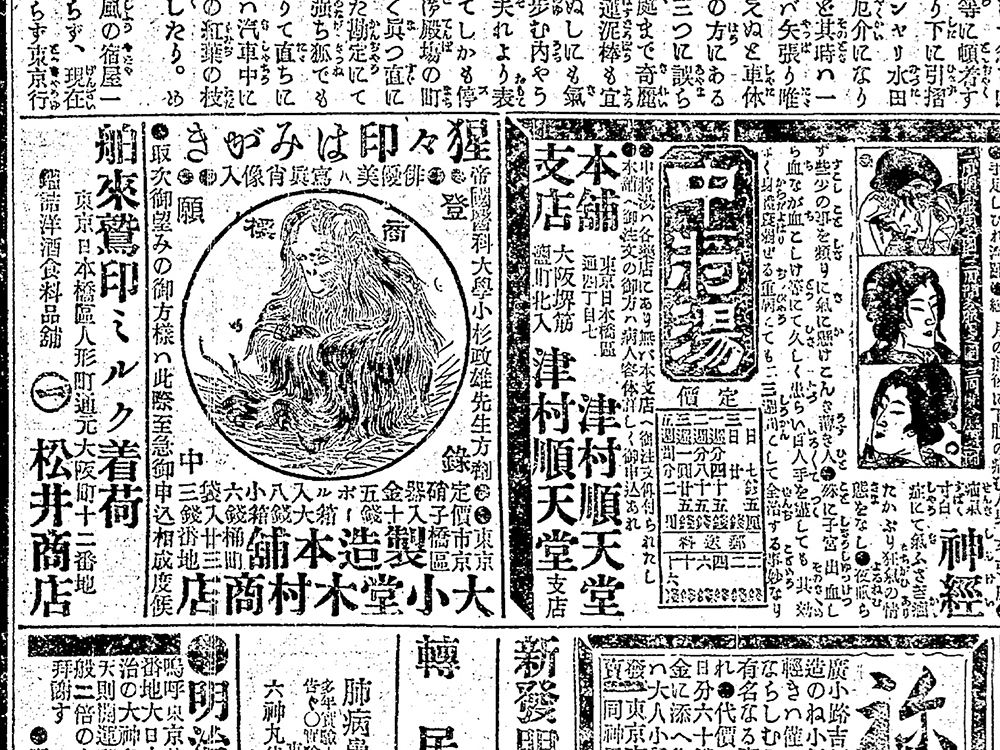
Figure 3: Orangutan-brand toothpaste’ in Asahi Shimbun (1898b).
“THE MURDERS IN THE RUE MORGUE” AS ShōjōKAI’
Edgar Allan Poe’s short story, ”The Murders in the Rue Morgue” [1841], is a murder-mystery, often credited as the first modern detective story, about a man named C. Auguste Dupin who attempts to solve the mystery of the brutal murder of two women in Paris by an unknown and seemingly superhuman assailant. The story was first translated in Japan by Kōson Aeba [饗庭 篁村; 1855—1922] as ”Rū morugu no hitogoroshi“ [ルーモルグの人殺し], serialised in the Yomiuri Shimbun newspaper from 14 to 30 December 1887. The second translation9 was Shūtō Osada’s [長田 秋濤; 1871—1915] ”Shōjōkai“ (猩々怪; lit., Supernatural Shōjō’), published in the literary magazine Bungei kurabu [文芸倶楽部; Literary Club] in October 1899.10 Despite the focus of the original story on the element of mystery and the detective-style logic of Dupin as he pieces together clues to solve the crime, Osada chose to frame the story as a supernatural tale in the tradition of Japanese kaidan (怪談). Not only did he translate the title as Shōjōkai’—kai (怪) signifying the presence of strange or supernatural elements—he also explicitly stated in his preface: ”This tale [kaidan] was told to me during my time in Paris” (此怪談は予が嘗て巴里に居つた時分、人から聞いた話で) (Osada 1899, 118). While the story certainly displays elements of the uncanny, Osada’s decision to reposition the story as a kaidan tale would seem unconventional were it not for the implied presence of a shōjō and the duality of its interpretation in the Meiji context.
”The Murders in the Rue Morgue” ends with the revelation that a sailor had recently captured an orangutan in Borneo and brought it back to Paris intending to sell it. Before he can do so, however, the orangutan escapes its enclosure and in a frightened state, on the loose in the streets of Paris, it accidently kills two women in the Rue Morgue. Ueno Zoo had of course acquired an orangutan one year prior to the publication of Osada’s ”Shōjōkai“. While the traditional shōjō certainly figures in the popular imaginary as a preternatural creature, the modern shōjō was very real, and for the Tokyo public in 1898—1899, the idea that a shōjō living in their midst could escape and wreak havoc on the city streets was perhaps frighteningly feasible. Thus, Osada’s translation hinges on an overlap of meaning, bringing the supernatural shōjō into dialogue with modern Japan and the presence of an actual shōjō in Ueno Zoo. The circumstantial overlap of an escaped orangutan in Paris and Ueno Zoo’s recent acquisition of its own orangutan becomes the contextual grounds for the introduction of a modern-day’ creature into the kaidan genre, and this for the potential threat it posed to the capital of modern Meiji society.
Notably, Osada’s translation seems to have intentionally emphasised this tension more so than in Poe’s original, such as a key scene in which Dupin is processing the clues of the crime and hands his companion a book with a scientific’ description of the animal. Poe’s source text describes the orangutan as a beast of the natural world and knowledge of the creature is widely understood:
It was a minute anatomical and generally descriptive account of the large fulvous Ourang-Outang of the East Indian Islands. The gigantic stature, the prodigious strength and activity, the wild ferocity, and the imitative propensities of these mammalia are sufficiently well known to all. I understood the full horrors of the murder at once.
(Poe 2009, 21)
By contrast, in Osada’s translation the very existence of the shōjō is a revelation and the implication that such a creature might be involved in the murder case incites confusion:
It was an anatomical record of the shōjō in the East Indies. While I was astonished to learn that such an animal even exists in the world, reading the account only added confusion to my thoughts surrounding the case.[16「東印度に於ける猩々の解剖論である、予は其書を読み、恁くの如き動物が、天地の間に存在して、居るかを見て、驚くと同時に、此事件は倍々予が考をして紊乱せしめた」]
(Osada 1899, 132)
As stated previously, until the increased introduction and assimilation of Western knowledge in the Meiji era, shōjō were generally regarded as quasi-mythical, water-dwelling, sake-loving creatures, known from folktales and Noh theatre. What Osada’s translation reflects, though, is a perception that perfectly encapsulates the transitory nature of knowledge surrounding the shōjō at this point in Japan’s history. While the nature of the orangutan in the 1841 original is ”sufficiently well known to all” (i.e., in Paris), the mere existence of a shōjō in Japan in 1899 is presented as cause for astonishment, highlighting the conflicting views of the shōjō as a fictional mythical creature and a real-life creature of modernity.
Indeed, a number of publications can be found in the early Meiji period that explicate the term shōjō’ as orangutan’, including Dōbutsu kunmō: Shohen (honyūrui) (動物訓蒙 初編 [哺乳類]; lit., Guide to Animals: Volume 1 [Mammals]’) in 1875, applying the same Chinese characters for the original preternatural shōjō (i.e., 猩々) to the real mammalian shōjō (i.e., orangutan), shown in Figure 4 (Tanaka 1875). Interestingly, Kōson Aeba’s initial 1887 translation of ”The Murders in the Rue Morgue” refers to the murderer as ”a giant monkey called an orangutan” (オラングウタンといふ大猿), suggesting the true identity of the animal was still relatively unknown to the wider public at that time.
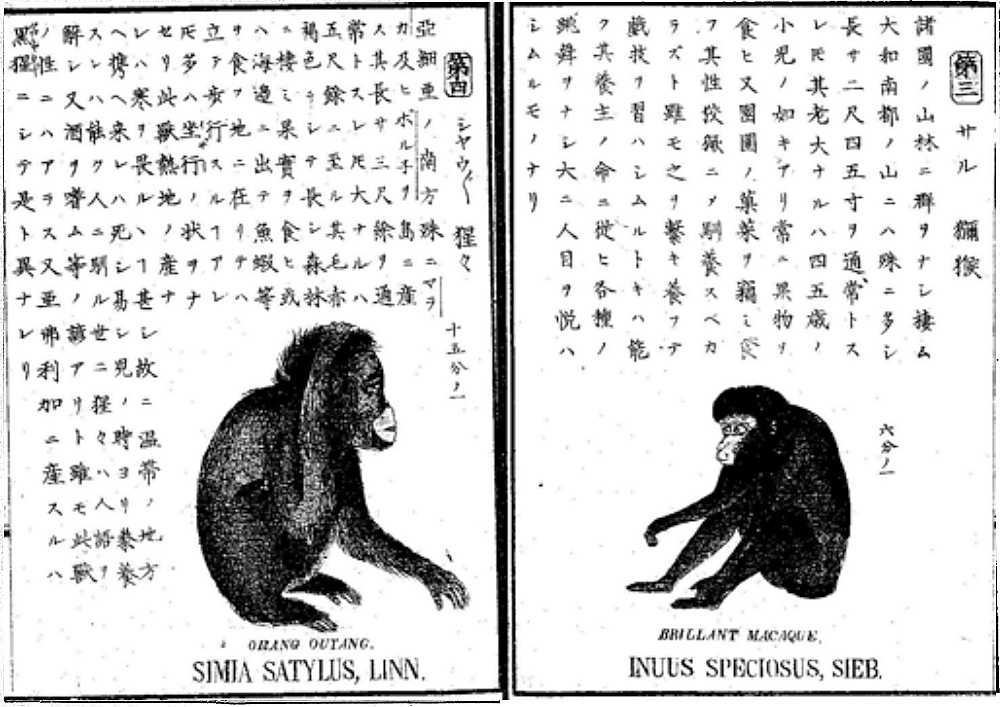
Figure 4: Shōjō (captioned ”Orang Outang”) in Dōbutsu kunmō [1875].
Following the introduction of a real shōjō into Ueno Zoo in 1898, a sudden rise in the number of publications relating to traditional tales of the shōjō surfaced—no doubt an attempt to capitalise on the recent fad for all things orangutan. In the same year that Osada’s ”Rue Morgue” translation was published, other stories and images appeared of the shōjō as both traditional, mythical creature and in its true form’ as an orangutan, including Kyōiku mukashibanashi: Shōjō no hanashi (教育昔話 猩々の話; Educational Old Tales: Story of the Shōjō’), shown in Figure 5 (Honekawa 1899, 15), and a compilation of artworks entitled Nōgaku zue (能楽図絵; Noh Studies Illustrated) depicting scenes from well-known Noh plays, including Shōjō (猩々) (Kawanabe 1899, 3—4). Particularly interesting for this study is an illustration in Nōgaku zue, depicting a Noh performer playing the role of a shōjō as a sake-drinking yōkai, while an actual shōjō (orangutan) appears from the side of the page as though revealing its true form to the reader (see Figure 6). As with Osada’s translation ”Shōjōkai“, this picture seems to represent how the Meiji individual may have processed knowledge about exotic animals like the orangutan. The dual presence of the mythical shōjō (adapted to the Noh tale) and the shōjō of the modern world (orangutan) reflects the multiple meanings, sites and audiences through which an understanding of the creature in the public imaginary developed, exemplifying the transitory state of knowledge of the shōjō during this period.
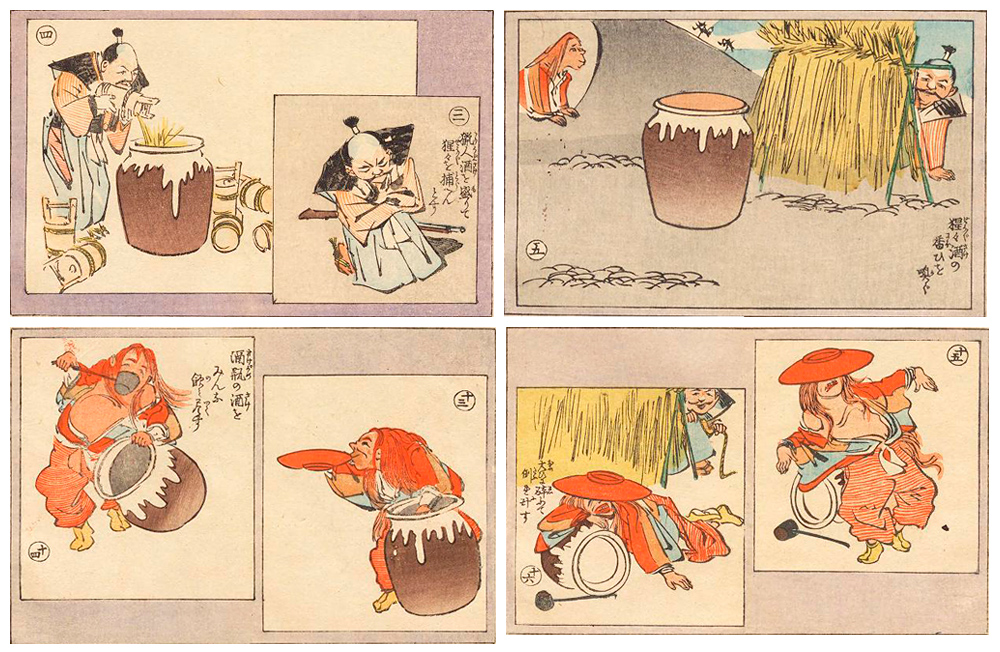
Figure 5: In this variation of the story, a man attempts to catch the shōjō by luring it out with a pot of sake and waiting for it to pass out drunk. From ”Shōjō no hanashi“ (猩々の話; The Story of the Shōjō’) in Kyōiku mukashibanashi [教育昔話; Educational Old Tales’], 1899.
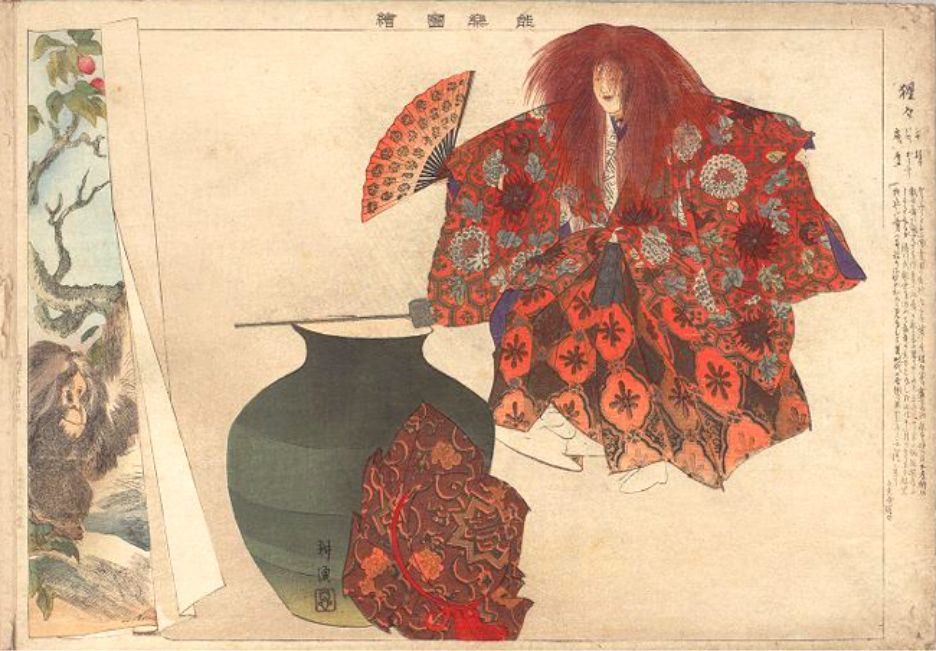
Figure 6: A creature of myth and modernity: Shōjō in Nōgaku zue (Tsukioka 1898, 54).
The fervor for the shōjō persisted throughout the Meiji era, particularly in the years following the introduction of Ueno Zoo’s first orangutan in 1898. But when new shōjō were introduced at the zoo in 1906 and 1909, these were still reported as shinchin (新珍; new curiosities). These new additions also roughly correspond with the translation of Rudyard Kipling’s ”Bertran and Bimi” [1891] as ”Shōjō monogatari“ (猩々物語) in the magazine Myōjō [明星] in 1908, and its retranslation as ”Shōjō“ in Bungei kurabu in 1909. By the end of the Meiji era, however, literature regarding shōjō suggests that people had come to distill fact from fiction and acknowledge a disconnect between knowledge of a traditional past and a modern present. The chapter ”Shōjō“ (211—19) in Sekai shinotogi (世界新お伽; New Fairytales of the World’) by Tokusuke Nakamura [中村 徳助] in 1910 includes, for example, the following explanation distancing modern orangutan from folkloric shōjō:
In the past, it was believed that shōjō were sake-loving bakemono that lived in the water. To catch a shōjō, you could place an open sake barrel by the sea and when the shōjō smelt the aroma of its favorite drink it would come up onto land. Once it had had its fill and fallen asleep drunk, you could grab it and tie it up. Whether that’s true or not is unknown, but shōjō did used to be known as sake-loving bakemono. The true shōjō, however, is not a bakemono but a relative of man. They say that monkeys are three hairs shy of human intellect. The shōjō [i.e., orangutan] may be a beast and member of the monkey family but it is even closer to man than the monkey, so it might even be only one hair shy of us.[17「昔は猩々は水の中に住んで酒の大好きな化物たど思って居ました猩々を釣るには海際へ酒樽の蓋をあけて出して置くと猩々が好物の香を嗅ぎつけて陸へ上りその酒をがぶがぶのむでしまいに酔ふて寝る時を見計って一時に引捕へるのだと云ひ傳へられましたそれはうそかほんとかわかりませぬが猩々は酒呑の化物にしてありましたほんとの猩々は化物ではありません人間の親類ですほんとうの猩々とはこんなものです人間に毛三筋たらぬのが猿だと云ひます猩々は猿の仲間の獣ですが猿よりまだ人間に近いもので丁度人間に毛一筋足らぬ位かもわかりません」The story proceeds to outline the differences between the shōjō (orangutan) and saru (猿; monkey), even drawing subsequent comparisons between shōjō, monkeys, and Japanese and Chinese people.]
(Nakamura 1910, 213)
Despite this acknowledgement, preliminary research suggests further investigation of the shōjō in later periods might continue to show an overlap of myth and modernity in the circulation of shōjō knowledge. An illustration in Yōichirō’s Minami [南 洋一郎] Hoeru mitsurin: Mōjū seifuku (吼える密林 猛獣征服; Roar of the Jungle: Conquest of Beasts’) published in 1938—26 years after the end of the Meiji era—depicts an alcohol-loving shōjō that is lured out of hiding with a giant pot of sake and captured, illustrating how traditional knowledge remained influential in preceptions of the creature well into later periods of ostensibly modern history (see Figure 7). What the popularity of the shōjō in Meiji Japan reveals is a much broader and persistent fascination with animal figures in the pursuit of scientific knowledge that continued well into the Shōwa era. Engagement with the animal kingdom, not only through public spaces such as Ueno Zoo, but also through the literature and printed media of the era, enabled the Meiji citizen to enrich their understanding of their expanding world and Japan’s place in it.
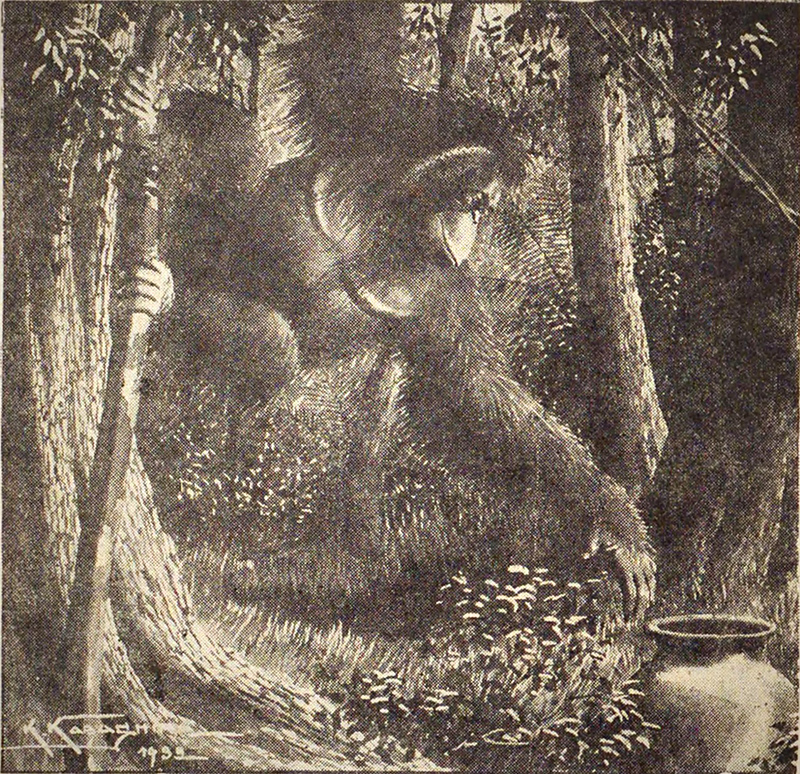
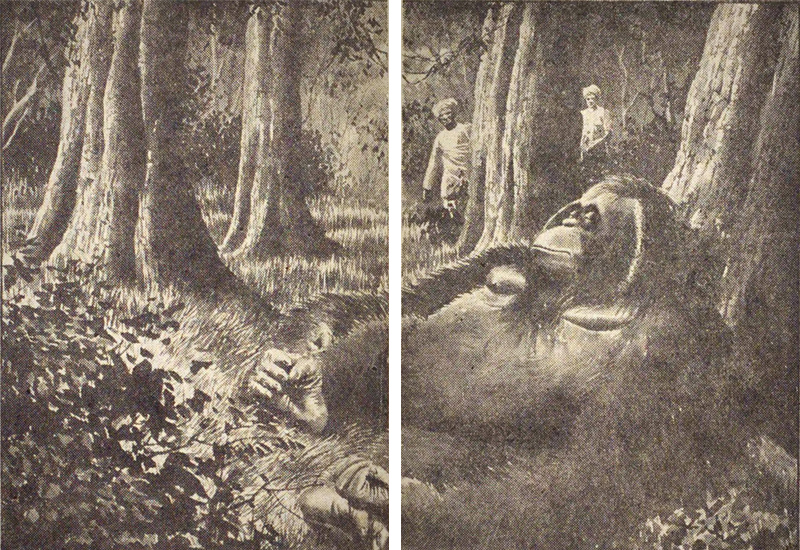
Figure 7: Hunters in Yōichirō Minami’s [1938] Hoeru mitsurin: Mōjū seifuku (吼える密林猛獣征服; Roar of the Jungle: Conquest of Beasts’) attempt to catch a shōjō (orangutan) by luring it with sake and waiting until it passes out (111, 116—17). Knowledge of the shōjō here continues to overlap with traditional tales, such as that described in Figure 5.
The sociocultural geography of the shōjō and the animal’s interpretation across a range of sites and contexts of meaning in this period intersects with what Secord (2004) terms ”knowledge in transit” (654—72). Through various categories of movement, dissemination and translation, the distinction between making knowledge and communicating knowledge becomes blurred, even illusory. For Secord, tracing acts of communication, including texts, images and objects, and giving attention to practices of knowledge circulation on a broad scale, can act as bridging studies between specific works and their wider contexts (666). Locating exotic creatures like the shōjō and their role in the Meiji literary imagination reveals the specific social, cultural and scientific contexts within which the connection between traditional culture, animals and modern science was constructed in this period and how representations of the shōjō transitioned through various knowledge systems, promulgated through translation. While Osada’s supernatural reimagining of Poe’s text, whether intentionally or instinctually, deviates from the source material, it reveals an awareness of the historical cache of mystery surrounding the shōjō. Foregrounding the uncanny aspects of the story, therefore, perhaps heightened the tension of Poe’s tale, effecting a reading that was more relevant and comprehensible to the Meiji reader. Ultimately, what the study of translation and translated literature provides is insight into another facet of knowledge production and transition, the act of translation demonstrating that transition’ here involves a process of manipulation as well as movement—of language, culture, and ideas.
CONCLUSION
This paper has outlined the significance of exotic animals in Meiji Japan with a focus on the intersecting representations of the shōjō (orangutan). Through an investigation of the printed media and translated literature that circulated concurrent to the import of the orangutan into Ueno Zoo, multiple interpretations of the shōjō can be identified from this era. Analysis of animal collection and exhibition practices of early- and pre-modern Japan, as well as the literary writings and topical articles that circulated through newspaper media of the Meiji era, highlights the various avenues through which the public constructed meanings from the ‘exotica’ that were imported animals. Th e thriving misemono business of the pre-Meiji period in particular, suggests that these attractions developed as sites of mystery, awe and sensory engagement, as many establishments provided not only the chance to witness these rare spectacles but also interact with them in multiple ways. However, in later periods, interaction with animals also became an act of consumption, as demonstrated by the commodification of animals as ‘war trophies’ (‘senrihin’, in which hin literally denotes an ‘item’ or a ‘product’) and as brands in product advertising (e.g., orangutan-brand toothpaste). To better understand the impact of the changes that influenced the ways knowledge about animals was processed in Meiji Japan, it is therefore necessary to examine the cultural practices of preceding eras.
Th e mid-nineteenth century, and specifically the bakumatsu (幕末; lit., ‘end of the bakufu’, referring to the end of the Tokugawa shogunal government, between 1853 and 1868), represents the transition from the Edo period to the new Meiji era, and with it, the creation of new sites and contexts for interactions with the natural world. Animals bear various cultural meanings and sociological implications in different societies, and such ideas evolve over time. Following the Meiji Restoration in 1868, animals were a crucial medium for the dissemination of Western thought and modern science imported through translation. A number of translations from this era not only draw upon animals to highlight the progression of scientific thought and the shifting relationship between man and nature, but also reveal the fervor for natural history and the classifying or categorising of new species, both plant and animal—exemplified by the newspaper article Daniel J. Wyatt New Voices in Japanese Studies, Vol. 9, 2017, pp. 71-93 88 cited above, which subjected the orangutan to meticulous measurement of its bodily dimensions. Th e pervasiveness of representations of exotic landscapes populated by foreign creatures in the printed media and translated literature of the Meiji period further reveals how a culture of natural science and animal collection in this era became bound to national identity. Th e role of exotic animals in Meiji Japan was therefore multifaceted, as they served as symbols of the modern world, not only for their value as items of trade between foreign nations but also for the associations that came to be drawn between the collection and exhibition of foreign animals and Japan’s concurrent imperial expansion. Th is is a process that accelerated and developed in parallel to Japan’s expanding commercial and eventually military presence in Asia.
Traditional cultural understandings of the shōjō certainly influenced the way the ‘modern day’ orangutan was interpreted by the general populace in Meiji Japan—the confusion surrounding the appearance of a monkey (orangutan) advertised as a ‘shōjō’ at sideshows in the early Meiji era illustrating the confrontation between traditional and scientific knowledge systems of this period. As demonstrated by Shūtō Osada’s reimagining of Poe’s “Th e Murders in the Rue Morgue” as a Japanese kaidan, however, cultural knowledge also facilitated a greater understanding of new foreign literature for people of a developing Meiji society more familiar with popular shōjō imagery and its connection to the other-worldly. Osada’s “Shōjōkai” reveals that knowledge is a process of dynamic, fluid and constantly changing ideas, impacted by greater society and changing institutional, cultural, economic, and political climates. Th e transition of knowledge, therefore, as demonstrated by multiple representations of the shōjō in the Meiji era, is not a linear process that sees the cultural transmission of images, ideas and beliefs shift swiftly towards a more scientific understanding; rather, it demonstrates a process of constant movement, inextricably linked to both culture and society, and highly susceptible to the influence of both human and non-human intermediaries. Th e producers and receivers of knowledge about the shōjō during the Meiji period included misemono proprietors, spectators, zoologists, the Meiji government, translators, journalists and general readers. Moreover, while the manifold representations of the shōjō visible in various forms of print media and translated literature of this era reflect the processes of a knowledge system in transit, they also reflect the very nature of translation itself.
GLOSSARY
akubyōharai (悪病払い) having properties that are able to ward off illnesses
bakemono (化け物) a shapeshifter; preternatural creature of Japanese folklore
bakumatsu (幕末) lit., ‘end of the bakufu’, referring to the end of the Tokugawa shogunal government
bu (分) 3.03 mm; a unit of measurement in the old Japanese system of weights and measurements, known as shakkanhō (尺貫法; shaku-kan system)
Bungei kurabu (文芸倶楽部) Literary Club; a literary magazine published by Hakubunkan publishing house from January 1895 to January 1933
bunmei kaika (文明開化) civilization and enlightenment
fūfuwagō (夫婦和合) conjugal harmony; successful marital relationship
gaikoku watari no dōbutsu (外国渡りの動物) imported beasts; imported animals
gun’yō bato (軍用鳩) war pigeons
gun’yō dōbutsu (軍用動物) military animals
gun’yō dōbutsu ireisai (軍用動物慰霊祭) lit., ‘military animal memorial service’
gun’yōken (軍用犬) war dogs
gyorui (魚類) rare and peculiar-looking fish
hakurai (舶来) imported (from overseas); foreign
hakurai chinjū (舶来珍獣) imported beasts; see also gaikoku watari no dōbutsu
hakurai dōbutsu (舶来動物) foreign animal; imported animal; see also gaikoku watari no dōbutsu
Hōtan (寶丹) A brand of multi-purpose powered medicine, sold during the late Edo period
ikoku (異国) foreign (in the context of this paper); foreign country
ikoku jōchō (異国情調) foreign air; exotic (exoticism)
ikoku jōsho (異国情緒) foreign air; exotic (exoticism)
ikoku shumi (異国趣味) interest in foreign things; exotic (exoticism)
ikokufū (異国風) foreign appearance; foreign-like; exotic (exoticism)
kaidan (怪談) ghost stories; tales relating to the supernatural
kaijū (海獣) sea beasts; used to refer to whales and seals
karatori or tōchō (唐鳥) foreign birds
kikai (奇怪) strange or uncanny; mysterious, especially in an unsettling way
kikei (畸形) deformity
misemono (見世物) exhibits; exhibitions; sideshows
nihonsan (日本産) domestic; native Japanese (in the context of this paper)
ōatari (大當り) a windfall; to strike it rich; big success
reijū (霊獣) ‘sacred beasts’, often an embellished title to attract customers to misemono exhibitions
reiyaku (霊薬) lit., ‘miracle drugs’
sakoku (鎖国) lit., ‘closed country’; referring to the policy of national isolationism that prohibited Japanese people from going abroad and heavily restricted foreign trade and diplomatic relations to a few select countries
senkō dōbutsu (戦功動物) distinguished animals of war
senkō dōbutsu kansha no kai (戦功動物感謝の会) lit., ‘gathering for the commemoration of distinguished war animals’
Senkintan (千金丹) a brand of multi-purpose medicine sold during the Meiji era, taken to relieve general pain or discomfort; also used for the treatment of hangovers
senrihin dōbutsu (戦利品動物) animal war trophies
shaku (尺) 30.3 cm; a unit of measurement in the old Japanese system of weights and measurements, known as shakkanhō (尺貫法; shaku-kan system)
shinchin (新珍) new curiosities
shōjō (猩々) orangutan; also, mythical creature of Japanese folklore and Noh tales (originating in China)
sun (寸) 3.03 cm; a unit of measurement in the old Japanese system of weights and measurements, known as shakkan hō (尺貫法; shaku-kan system)
tennen kibutsu (天然奇物) natural curiosities; natural phenomena; natural oddities
to (斗) approximately 18 litres; a unit of measurement in the old Japanese system of weights and measurements, known as shakkanhō (尺貫法; shaku-kan system)
tōchō (唐鳥) see karatori
yōkai (妖怪) preternatural creature of Japanese folklore
- Other such precincts included: Shijō Kawaramachi (四条河原町) in Kyoto; Nanba Shinchi (難波新地) and Dōtonbori (道頓堀) in Osaka; Asakusa (浅草) in Tokyo; and Ōsu (大須) in Nagoya. ↩
- The thousand-year-old mole’ was really just a mami (貒; badger), but thinking that customers would not likely be drawn to a show advertising a mere badger, one misemono proprietor decided to focus on the fact that the legs of his badger resembled a mole’s and announced that his specimen was a ”king mole that had lived a thousand years” (千歳を経た土龍の王である) (Asakura 2002, 183). ↩
- Kara (唐)—originally referring to Tang dynasty China (618—c.906 CE)—is a term that came to be used thereafter in Japan to describe imported items of Chinese or otherwise foreign’ origin. During the Edo period, parrots and non-native birds were commonly imported to Japan via China, and as most people were not aware that these birds actually came from regions in Southeast Asia and India, they were initially ascribed the label karatori’ or tōchō (唐鳥) using the ideograms for China (唐) and bird (鳥) (see Sugano 2004, 26). ↩
- Later Furukawa also uses the terms hakurai dōbutsu (舶来動物; imported animals) and hakurai chinjū (舶来珍獣; imported beasts). ↩
- The full name was the Museum of Natural History (Zoological Garden Annex), Natural History Division, Ministry of Agriculture and Commerce, Empire of Japan’ (大日本帝国農商務省博物局博物館付属動物園). ↩
- These events included live demonstrations of gun‘yōken (軍用犬; war dogs) and gun‘yō bato (軍用鳩; war pigeons) performing their military duties (Ueno Zoological Gardens 1982, 667). ↩
- Exotic imagery was certainly not new to Japanese art or literature by the beginning of the Meiji era. With the evolution of a consciousness towards the exotic in the later Meiji period, however, the exotic image was gradually elevated from its traditional function of narrative ornamentation to become the pivot of artistic motivation. Mokutarō Kinoshita’s (木下 杢太郎; 1885—1945) poetic cycle ”Ikoku jōchō“ (1910) is thought to be the first occurrence of the term in a creative context. From this point onwards, translations of exotic’ and exoticism’ also came to include multiple variations of the English pronunciation using katakana loanwords, such as ekizochizumu (エキゾチズム), ekizochisumu (エキゾチスム), and ekizochishizumu (エキゾチシズム), as well as various translations, including ikoku jōchō’, ikoku shumi (異国趣味), ikoku jōsho (異国情緒), and ikokufū (異国風). ↩
- Synopsis taken from Nishino (1998, 412—14). ↩
- Kawato and Sakakibara (1997) also list ”Tsutamomiji“ (蔦紅葉;; Scarlet Ivy’) as an adaptation of the story that was serialised over 47 installments in the Yamato Shimbun newspaper from 3 November to 29 December 1892. The story resituates the original Rue Morgue (Paris) murders in Tokyo, at ”Building 92 of the Tsukuji foreign settlement quarters” (築地居留地第九十一番館), where the murders of a foreign mother and her daughter are committed at the hands of a hihi (狒々; baboon) (Yamato Shimbun 1892). However, as I have not confirmed the content of this story, I have chosen not to include it in my analysis. ↩
- A third translation appeared in 1909, as a partial translation, in the January edition of the English study magazine Eigo seinen (英語青年´), titled ”Kōzetsu sōzetsu: Moruguchō no zansatsu jiken“ (凍絶愴絶モルグ町の惨殺事件; lit., Bloody Tragedy: The Morgue Town Massacre’) by Yoshijirō Fukazawa (深沢 由次郎). ↩

